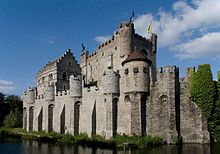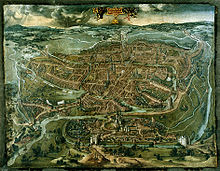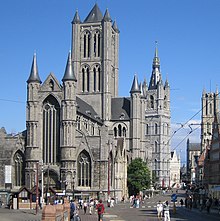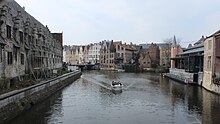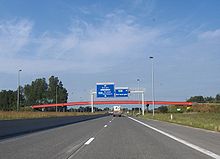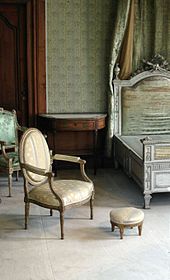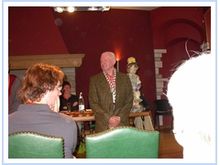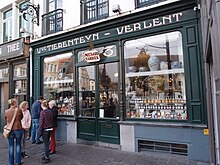Ghent
| Ghent | ||
|---|---|---|

|

|
|
|
|
||
| State : |
|
|
| Region : | Flanders | |
| Province : | East Flanders | |
| District : | Ghent | |
| Coordinates : | 51 ° 3 ' N , 3 ° 43' E | |
| Area : | 156.18 km² | |
| Residents: | 262,219 (Jan 1, 2019) | |
| Population density: | 1,679 inhabitants per km² | |
| Post Code: | 9000-9052 | |
| Prefix: | 09 | |
| Mayor: | Mathias de Clercq | |
Local government address : |
Botermarkt 1 9000 Gent |
|
| Website: | stad.gent | |
Ghent ( Dutch [ ɣɛnt ] / [ ʝɛnt ], French Gand [ gɑ̃ ]) is the second largest city in Belgium after Antwerp . It is also the capital of the province of East Flanders and the arrondissement and electoral district .
Ghent arose from Celtic settlements in the area of the confluence of Scheldt and Lys . In the Middle Ages , the flourishing cloth trade made Ghent one of the largest and most important cities in Europe . The flax and linen trade and the staple rights to grain acquired by the city also contributed considerably to the city's welfare. After a brief Calvinist period, the city fell into disrepair until it flourished again at the end of the 18th century, when Ghent became one of the first industrialized cities on mainland Europe.
The future Emperor Charles V was born in Hof ten Walle, later the Prinzenhof , on February 24, 1500 . It was in the city that the Pacification of Ghent (1576) and the Peace of Ghent (1814) were signed.
Ghent is also called “the proud city” ( de fiere stad ) or - after the champions of its urban freedom - Arteveldestadt . Because of its location in an extensive area of flower and plant breeding companies, Ghent is also known as the city of flowers .
The patron saints of Ghent are Saint Lieven and Pharaildis . Saint Bavo is the patron saint of the Ghent diocese , after which the Saint Bavo Abbey and later also the Saint Bavo Cathedral are named. The wealthy citizens of the city built the Sint-Niklaaskerk on Kornmarkt in the 13th and 14th centuries .
geography
location
Ghent is located in the middle of an urban area. Thus Brussels in the southeast and Antwerp each km in the northeast about 50, while as far as Bruges , Kortrijk and Roeselare are km to the west about 40 microns. The city lies at the confluence of the Scheldt and Leie rivers . With an area of 156.18 km², Ghent has 262,219 inhabitants (as of January 1, 2019) and a population growth of 0.6%.
Residents
The metropolitan region of the city has an area of approximately 1205 km². 594,582 people live in it (Jan. 1, 2008), making the Ghent metropolitan region the fourth most populous in Belgium. The central agglomeration has 278,457 inhabitants, the immediate vicinity ( banlieue ) increases the number to 423,320. With the outermost living and influence zone ( forensenwoonzone ) the number adds up to 594,582.
City center
The city center is divided into several cores dating back to earlier settlements, the difference between the historical medieval center in the so-called "Wanne" ( De Kuip ) and the significantly higher area of the former St. Peters Abbey on the Blandinberg is particularly noticeable.
climate
The city's climate is shaped by the nearby North Sea ; the daytime temperatures are usually pleasant in summer and winter: night frosts are just as rare as midday temperatures of over 30 ° C.
City structure
overview
Today, Ghent does not only consist of the historical, densely built-up and inhabited city center, consisting of the center sitting in the “tub” and the abbey quarter on the Blandinberg. As is the case with many other cities, the original urban area in the 19th and 20th centuries was built as a working-class district, and here, too, there is dense development. To the south is the station district from the beginning of the 20th century. Beyond there begins the outskirts, the buildings of which have developed primarily on the major failure routes and have increasingly integrated the surrounding village centers. The city of Ghent is divided into 25 districts, which mainly in the center coincide with historical quarters and neighborhoods. Beyond this, the administrative structure in sub-municipalities is essentially the same as the socio-cultural and historical structure.
Since the municipal mergers of 1965 and 1977, Ghent has consisted of the following sub-municipalities:
| # | Surname | Area (km²) |
Population in 1997 |
|---|---|---|---|
| I. | Ghent | 112,831 | |
| II | Mariakerke | 11,558 | |
| III | Drongen | 12,213 | |
| IV | Wondelgem | 12,327 | |
| V | Sint-Amandsberg | 21,567 | |
| VI | Oostakker | 13,457 | |
| VII | Desteldonk | ||
| VIII | Mendonk | ||
| IX | Sint-Kruis-Winkel | ||
| X | Ledeberg | 7,955 | |
| XI | Gentbrugge | 19,812 | |
| XII | Afsnee | ||
| XIII | Sint-Denijs-Westrem | 6,755 | |
| XIV | Zwijnaarde | 6,918 |
Neighboring communities
Ghent borders on the following sub-municipalities:
- Wachtebeke (municipality of Wachtebeke ),
- Zaffelare ( Lochristi municipality ),
- Lochristi, with the village of Hijfte (Lochristi municipality)
- Destelbergen (municipality of Destelbergen )
- Heusden (Destelbergen municipality)
- Melle (municipality of Melle )
- Merelbeke ( Merelbeke municipality )
- Zevergem ( De Pinte municipality )
- De Pinte (municipality of De Pinte)
- Sint-Martens-Latem (municipality of Sint-Martens-Latem )
- Sint-Martens-Leerne (municipality of Deinze )
- Vosselare (municipality of Nevele )
- Landegem (municipality of Nevele)
- Merendree (Nevele municipality)
- Vinderhoute (municipality of Lovendegem )
- Lovendegem (Municipality of Lovendegem)
- Evergem, with the villages of Belzele and Wippelgem ( Evergem municipality )
- Kluizen ( Evergem municipality )
- Ertvelde, with the village of Rieme (Evergem municipality)
- Zelzate ( Zelzate municipality )
history
Stone Age to the end of the Bronze Age
The oldest find that proves the presence of people in the Ghent area is a hand ax that is around 70,000 years old. Then there is a huge gap that extends to the arrival of the first farmers on the sandy soil that has been avoided for a long time. The first remains of these earliest farmers are dated from around 2000 to 1800 BC. Dated. The local group is culturally associated both with the Hilversum culture in the north and with the northern French Eramécourt group in Picardy . In the late Bronze Age, people followed the urnfield culture .
Celts, Romans, Franks
Around 700 BC The Iron Age began. In Celtic times, especially during the La Tène culture from around 500 to 400 BC. In the region where the rivers Scheldt and Leie converge, there were several settlements. Floods occurred regularly, so the land continued to be more suitable for sheep breeding than for farming. In the Ghent area, however, this culture can only be made probable to date. The name Gent comes from the Celtic water name Gond , which became Ganda among the Germans , from which the Latin Gandavum is derived. Ganda is often translated as confluence, confluence .
The tribes around Ghent, the Nervi and the Menapi, are better known through the Romans . Although the area was around 50 BC. BC Roman, but the first traces of Romanization can only be found under Emperor Claudius . Road construction, building materials and techniques were gradually adopted by the Romans. Roman remains were found in several places in Ghent, for example on Gravensteen , in the Pekelharingstraat, the Schouwburgstraat, at the St. Bavo Cathedral , on the Botermarkt, in the St. Pieters Abbey, on the Hogeweg and in Sint-Denijs-Westrem . Most of them date from the 2nd and 3rd centuries. Around 400 the place was taken by the Franks .
Carolingians, main monasteries
Two abbeys were founded in the 7th century: the monastery of St. Bavo (around 625–650) and Blandinium , the later monastery of St. Peter (after 650). They had a decisive influence on the development of the city. As early as 800, the city must have been so important that Ludwig the Pious appointed the Karlsbiographer Einhard as abbot of both abbeys.
Charlemagne tried in vain to repel the Vikings by building a fleet. In 851/852 and between 879 and 883 they devastated the city and plundered the area around Ghent. For a long time they settled on the Scheldt , here at the height of today's Duivelsteen, Sankt Bavo, Biezekapelstraat, Wijdenaard. At the end of the 9th century a castle was built by Baldwin II the Bald on the site of today's Gravensteen . The inhabitants regrouped around this place and around the Graslei on the Leie . Ghent grew out of different cores to form a larger city, which initially comprised around 7 hectares.
Urban autonomy, textile metropolis

The oldest town church can be seen since 949. The first bench of lay judges stood there from the 12th century. The first city wall was probably built at the end of the 10th century, Ghent expanded and new municipalities emerged, namely Sint-Jacob, Sint-Niklaas and later Sint-Michiel. In the 11th century, Ghent became a textile manufacturing metropolis and a far-reaching economic power. The city, with its centerpiece at the Botermarkt, was the largest city in the Netherlands until around 1550 ; outside of Italy, only Paris was larger. It grew to 80 hectares, the canal belt around the city even covered 644 hectares. As early as the 13th century, the city had fifty to sixty thousand inhabitants and more and more houses were being built from stone. Devastating city fires had broken out in 1120 and 1128. The fortifications were enlarged and the gates reinforced - an expansion that did not end until the 18th century. Emperor Charles V said of Ghent: Je mettrai Paris dans mon gant / Gand (“I could put Paris in my glove / my Ghent”).
Around 1100 the Count of Flanders granted the city its own bench of lay judges. The city slowly grew into an autonomous power with independent institutions. Ghent has always been a rebellious city striving for autonomy. For centuries the citizens fought against their respective princes in order to preserve or increase their privileges or freedoms. The nobility had to cede a large part of power to the merchant families.
Rule of 39; internal conflicts
Until 1302 a number of well-to-do bourgeois families, the so-called XXXIX (39 Ghent lay judges), ruled, as politics and jurisdiction were in their hands. These patricians formed a closed group, got rich through the trade and production of cloth and linen, as well as the economic rule over the surrounding area. They tried to protect their interests, so they often stood on the side of the French king and against their direct master, the Count of Flanders, which earned them the nickname Leliaerts .
In 1297 Count Guido I of Flanders deposed the Council of XXXIX. After the defeat by France in the Battle of Veurne , he could only stay in Ghent. He had to make peace in 1298 and give up in 1300. After the uprising of Bruges against the French king and the success in the Spore Battle in July 1302, the guilds and small businesses were given the right to co-opt lay judges , which resulted in a form of government in which the guilds had a larger share. The new government also fought against the claims of the princes, especially against their fiscal claims; this with success, especially since the count and his son and successor Robert III. spent several years in French captivity. The more the guilds and merchant families gained in power and influence, the more they insisted on their independence. The peasants under the leadership of Nicolaas Zannekin (until 1328), who also marched before Ghent in 1325, rose against the rule of the counts, but they failed because of its walls.
Role in the Hundred Years War
During the first phase of the Hundred Years War (1338–1453), Ghent finally opted for the English side after initial neutrality because the city was dependent on the import of raw materials for textile production and the English had blocked imports. Jacob van Artevelde , a wealthy cloth merchant, led an uprising against Ludwig II of Nevers because he was on the side of the French king.
In the middle of the Friday market is a statue of the city governor and merchant Jacob van Artevelde, who on January 26, 1340 King Edward III. received by England and recognized as the rightful French king after the Ghent guilds had allied themselves with the English under his authoritarian leadership to take action against the French nobility.
However, social conflicts did not fail to appear ('den quaden maendach') and five years later the Walkers called for an uprising who wanted to overthrow the weavers under Artevelde. There were fights on the Friday market as a prelude to the murder of Jacob van Artevelde, who was murdered on July 17, 1345 in his apartment on the Kalandeberg.
After the Goede Disendach , the good Tuesday, the new Count Ludwig van Male was recognized. Nevertheless, it remained restless in Ghent, the people demanded a say and the well-organized guilds took part in the political disputes. In 1369 the distribution of the lay judges' offices was adjusted. From then on, three representatives from the porters, 5 of the 53 small trades and 5 of the large guilds were accepted into the council of lay judges. The count tried constantly to get power into his hands, which led to uprisings, such as 1379-1385 under the leadership of Jan Hyoens, Frans Ackerman and Philipp van Artevelde , the son of Jacob. The uprising began with the murder of Count Baljuw , who did not adequately respect Ghent's privileges. On several occasions the insurgents, with the support of the guilds in other cities, succeeded in dominating almost the entire county of Flanders . Artevelde, the Ghent against the French army under the leadership of King Charles VI. and headed Ludwig van Male, died in 1382 in the battle of Westrozebeke . (See also: Battle of Roosebeke ).
This first major uprising ended without a decision in December 1385 with the Peace of Doornik, concluded with the new Count Philip the Bold of Burgundy . In 1384 Ghent came to the Duchy of Burgundy because Duke Philip the Bold had married the heiress Margaret of Flanders . The handling of privileges did not change, there was even an amnesty for every form of insurrection, but Ghent had to give up its alliance with England and recognize the King of France. However, when the Burgundian restricted the power of the guilds , there was another uprising. The fighting was fierce, but eventually the Ghent merchants had to surrender to the Burgundians. The dispute over salt and grain taxes lasted three years. In 1407 the Council of Flanders was established in the city , using Dutch as the language of business .
Burgundians, Habsburgs (1453–1477 or from 1477)
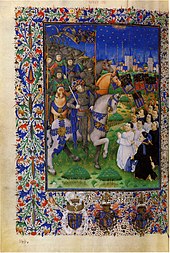
The House of Burgundy became the new opponent of the city, which at first also opposed Philip the Good. On July 23, 1453, the decisive battle of the Scheldt finally took place . The 30,000 men of the city army could not achieve a victory. Duke Philip the Good had the councilors in their penitent shirts go outside the city and ask for mercy. Only after this battle did Ghent accept Burgundy rule, which only lasted until 1477. For more than twenty years, the Burgundians dominated, the richest and largest urban landscape in Europe after Northern Italy.
In 1477, the Habsburgs acquired Flanders, and with it Ghent, through the marriage of Mary of Burgundy to the later Emperor Maximilian I. This time, too, the merchants fought vigorously for their independence, especially from 1485 onwards. However, after the beheading of Jan van Coppenolle sign the Peace of Cadzand on July 29, 1492 . This severely curtailed the city's independence, a situation that only changed again after the uprising of 1540.
Uprising, end of autonomy, Calvinism (1537–1568)
In the sixteenth century, Ghent played an important role in the rise of Calvinism . In 1537 the city refused to comply with the request of provincial governor Maria of Hungary to support the wars of Emperor Charles V , who was born on February 24, 1500 in the Ghent prince's court, against France. The following uprising was suppressed with great severity by the emperor, who beheaded the leaders on Gravensteen in 1539. When the political leaders asked for forgiveness in 1540, Ghent was subjected to a new statute, the so-called Concessio Carolina . Klokke Roeland , the symbol of Ghent's independence, was removed from the belfry, and a new castle, the Spaniard fort, was to watch over the Ghent people from now on.
The leaders of the uprising had to ask for forgiveness in penitential dress with a noose around their necks, which was reflected in the city's cultural memory as an expression of their disempowerment. In the eyes of strangers, all Ghent residents shared the lot of the Creesers (krijsers). The Ghent was not meant by this nickname. Strict sanctions quickly came against those who dared to use this word, from simple journeymen (“up u bloot lichaem totten bloede”) to the extreme case of a lieutenant who was hanged on the gallows in 1578.
After Ghent fell to Charles' son Philip II of Spain in the middle of the 16th century , the Protestant residents rose up against the Catholics from Spain, who in turn reacted with a regime of terror. The execution of the governor of Flanders, Count Lamoral von Egmont , in 1568 sparked the liberation struggle of the Netherlands under William of Orange .
The Ghent Republic (1577–1584)
During the Eighty Years' War in 1576 the assembled States General concluded the Ghent Pacification , a denominational peace between Catholics and Protestants. Between 1577 and 1584 Ghent existed as a Calvinist city republic, under the leadership of Jan van Hembyze and François van Ryhove .
At that time, Ghent's first (theological) university in “Het Pand” (now restored and owned by the University of Ghent ) was founded. After the city was taken by the Duke of Parma Alessandro Farnese on August 17, 1584, the Calvinists fled the country, mainly towards the northern Netherlands.
During this time a new military rampart was built, which is very clearly visible on the map by Guicciardini from 1612 in comparison with that by Braun & Hogenberg from 1576.
Economic decline (around 1600 to 1750)
Ghent belonged to the Spanish Netherlands from 1522 to 1714 , then to the Austrian Netherlands until 1795 . During the Dutch War , Ghent was taken by French troops. Due to the Peace of Nijmegen in 1678, the occupiers withdrew.
From the end of the 16th to the middle of the 18th century, Ghent's economy fell into disrepair, with the population falling from over 50,000 to 31,000 by 1650. With the Peace of Westphalia in 1648, the city also lost the connection between its port and the sea via the Sassevaart to the Westerschelde . A new canal at sea was opened in 1623 with the Gent – Brugge Canal.
Economic recovery, industrialization, Napoleon (around 1750 to 1815)
The settlement of new businesses in the second half of the 18th century brought Ghent back to economic prosperity, so that in the 18th century it grew again to become the largest city in present-day Belgium. It remained the largest city in Belgium until the famine from 1845 to 1848. At the end of the 18th century, Ghent was the first city on mainland Europe to begin industrialization , primarily through the introduction of mechanical linen and cotton processing and facilitated by Lieven Bauwens' smuggling of a spinning machine from England , the “Mule Jenny ". From then on, Ghent was an important industrial textile city. The excavation of the Coupure (1751–1753), which was carried out under Maria Theresa and connected the Leie with the Brugse Vaart, also provided an upswing.
In the revolutionary wars following the French Revolution , French troops conquered Flanders, and with it Ghent, in 1794. The Vonckist democratic movement had found supporters here as early as 1780. The number of residents had also increased again. By 1800 Ghent had 52,000 inhabitants again. Between 1801 and 1815 over 8,000 people immigrated to Ghent; Above all, the continental barrier (since 1806) gave the city an increased boom in the textile industry. From 1789 Jews settled in the city. Their community grew to 106 people by 1817, but the clergy, who increasingly ruled the city, created a rather hostile climate, so that immigration came more from rural imperial communities than from commercial cities.
In 1814 the Rijksuniversiteit was founded and in 1817 it had 190 students.
On December 28, 1814, the Peace of Ghent was concluded between England and the USA in Ghent . During the reign of the Hundred Days of Napoleon, King Louis XVIII held out. in the city for a long time.
Part of the United Netherlands (1815 to 1830)
In 1815 the city became part of the Kingdom of the United Netherlands due to the resolutions of the Congress of Vienna . During this time Ghent became a university town in 1816/1817, and the Ghent – Terneuzen canal was built in 1825–1827 to connect the places of the textile industry to the large markets.
The streets of London and Paris had already received gas lighting in 1812 and 1815, respectively . Ghent also built its first gasworks around 1827 (the first in Belgium), which allowed the city to replace 700 street torches with safe gas lamps after two years . Two more came to the first gasworks, including the one on Gasmeterlaan, of which two metal skeletons from gas containers have been preserved. They stand on the property of De Nieuwe Molens and are protected as industrial monuments.
During the Dutch period, the citadel of Ghent was also built to defend against France.
Second city in Belgium, expansion (since 1830)
In 1830 Ghent had 83,843 inhabitants. The Ghent cotton weavers have now found a large market in the Dutch East Indies , which explains why the local industrialists were less taken with the Belgian Revolution . When Belgium became an independent kingdom in 1830, a large part of the Ghent citizenship remained orangistically- minded ( Hippolyte Metdepenningen ), even if the upper class mostly spoke French. After 1848 the Orangists became part of the liberal party. Ghent is also the city where the first modern trade unions and the Belgian socialist movement emerged in Belgium .
In 1860 the customs law on goods imported into the city was abolished and the city gates were demolished. Industry strengthened outside the center, and new quarters could be built in place of the old ramparts. In 1913, Ghent hosted the World's Fair that took place in the south of the city. With a view to the Expo, the Gent-Sint-Pieters train station was opened on the nearby new Maria-Hendrikaplein. After this world exhibition, the expo area became the Miljoenenkwartier .
During the two world wars, Ghent was largely spared from shelling and bombing, so that only a few war casualties were to be mourned and numerous historical buildings were preserved.
Through incorporations in 1965 and 1977, the city took on former neighboring communities as districts. This increased the area of the city to 15,600 hectares and the population to 246,171.
Population development
Since 1977 Ghent has lost many residents to more resident fringe communities. In 1999 Ghent had a little under 224,000 inhabitants. With the influx of migrants and successful urban renewal, the population has been rising again since then. At the end of 2013, Ghent had 250,281 inhabitants.

- Sources: Nationaal Instituut voor de Statistiek and City of Ghent ( Memento from December 13, 2012 in the Internet Archive ) (sub-municipality Ghent after 1977; PDF, 528 kB)
- 1806 to 1970 inclusive: population censuses; from 1977: Population on January 1st
- 1927: incorporation of parts of Desteldonk, Ertvelde, Evergem, Kluizen, Mendonk, Oostakker, Sint-Kruis-Winkel and Zelzate (+ 8 km² with 1,250 inhabitants)
- 1965: Incorporation of Desteldonk, Mendonk and Sint-Kruis-Winkel as well as incorporation of areas of Kluizen, Oostakker, Wachtebeke and Zaffelare (+ 31.08 km² with 3,200 inhabitants)
- 1977: incorporation of Afsnee, Drongen, Gentbrugge, Ledeberg, Mariakerke, Oostakker, Sint-Amandsberg, Sint-Denijs-Westrem, Wondelgem, Zwijnaarde; plus integration of an area between Gent (Zwijnaarde) and Merelbeke (+ 87.34 km² with 108,952 inhabitants)
politics
City officials
After the municipal council election in 2018, the following council was formed.
| Rats College of Mayor and Schöffengrund ( Assistant ) | ||
|---|---|---|
| function | Surname | Responsibilities |
| mayor | Mathias de Clercq ( Open VLD ) | |
| Aldermen | Sofie Bracke ( Open VLD ) | Port, economy and business |
| Bram van Braeckevelt ( Groen ) | Personnel matters, labor and social issues | |
| Astrid de Bruycker ( sp.a ) | Equal opportunities, prosperity and public green | |
| Rudy Coddens ( sp.a ) | Health, care and poverty reduction | |
| Elke Decruynaere ( Groen ) | Education, upbringing, youth | |
| Mieke van Hecke ( CD&V ) | Registry office | |
| Tine Heyse ( Groen ) | Environment, climate, energy and the north-south relationship | |
| Sami Souguir ( Open VLD ) | Urban development, spatial planning | |
| Annelies Storms ( sp.a ) | Culture, tourism and events | |
| Filip Watteeuw ( Groen ) | Transport and urban development | |
The mayors of Ghent since the post-war period were:
- 1944–1946 - Edward Anseele Jr. (socialist)
- 1947–1952 - Emile Claeys ( CVP )
- 1953–1958 - Laurent Merchiers ( PVV )
- 1959-1970 - Emile Claeys ( CVP )
- 1971–1976 - Geeraard Van Den Daele ( CVP )
- 1977–1982 - Placide De Paepe ( CVP )
- 1983–1988 - Jacques Monsaert ( CVP )
- 1989–1994 - Gilbert Temmerman ( SP )
- 1995-2006 - Frank Beke ( SP-sp.a )
- 2007-2018 - Daniël Termont ( sp.a )
- 2018– - Mathias de Clercq ( Open VLD )
Results of municipal elections since 1976
On January 1, 1977 Ghent merged with the formerly independent municipalities Afsnee, Drongen, Gentbrugge, Ledeberg, Mariakerke, Oostakker, Sint-Amandsberg, Sint-Denijs-Westrem, Wondelgem and Zwijnaarde.
| Political party | October 11, 1976
53 seats |
October 10, 1982
51 seats |
October 9, 1988
51 seats |
October 9, 1994
51 seats |
October 8, 2000
51 seats |
October 8, 2006
51 seats |
October 14, 2012
51 seats |
October 14, 2018
53 seats |
|---|---|---|---|---|---|---|---|---|
| SP / sp.a - spirit / sp.a - Groen | 13 | 15th | 16 | 13 | 14th | 17 (14 + 3) | 26th | 7th |
| PVV / VLD / Open Vld | 14th | 11 | 12 | 13 | 11 | 11 | 9 | 15th |
| Vlaams Blok / Vlaams Belang | 2 | 7th | 11 | 9 | 3 | 4th | ||
| CVP / CD&V - N-VA | 19th | 17th | 15th | 12 | 10 | 8 (7 + 1) | - | - |
| CD&V | - | - | - | - | - | - | 4th | 3 |
| VU / VU&ID / N-VA | 7th | 7th | 3 | 1 | 1 | List connection with CD&V | 9 | 6th |
| Agalev / Groen! | 1 | 3 | 5 | 4th | 6th | with sp.a | 14th | |
| independently | - | - | - | - | - | - | 1 | |
| PVDA | - | - | - | - | - | - | 3 |
- The underlined numbers indicate the coalition majority.
The next municipal council will be elected for 6 years in 2024.
| Political party | Voices 2012 | % 2012 | Seats 2012 | Voices 2018 | % 2018 | Seats 2018 |
|---|---|---|---|---|---|---|
| sp.a - Groen | 69,356 | 45.48 | 
|
53,179 | 33.5 | 21st |
| N-VA | 26,064 | 17.09 | 
|
19,167 | 12.1 | 6th |
| Open Vld | 25,167 | 16.50 | 
|
19,167 | 25.2 | 15th |
| CD&V | 13,834 | 9.07 | 
|
13,979 | 8.8 | 4th |
| Vlaams Belang | 9,966 | 6.53 | 
|
12,354 | 7.8 | 4th |
| PVDA | 4,431 | 2.91 | / | 11,178 | 7.1 | 3 |
| Rood! | 1,561 | 1.02 | / | - | - | - |
| Pirate party | 1.106 | 0.73 | / | - | - | - |
| LijstLijst | 458 | 0.30 | / | - | - | - |
| BOY | 333 | 0.22 | / | - | - | - |
| Solids | 236 | 0.15 | / | - | - | - |
| Duw.Gent | - | - | - | 3,229 | 2 | - |
| BE.One | - | - | - | 1,709 | 1.1 | - |
| Gentse Burgers | - | - | - | 1,633 | 1 | - |
| PissOff | - | - | - | 931 | 0.6 | - |
| MPR | - | - | - | 498 | 0.3 | - |
| VMC | - | - | - | 480 | 0.3 | - |
| Mirror partij | - | - | - | 329 | 0.2 | - |
| 152,512 | 95.90 | 51 | 158,545 | 95.7 | 53 | |
| invalid / abstention | 6,528 | 4.10 | 7.148 | 4.3 | ||
| 159.040 | 100 | 51 | 165.693 | 100 | 53 |
Attractions

Much of the medieval and early modern building stock has been preserved: Ghent has more than 9800 registered, culturally and historically valuable buildings, most of which are also listed . The city competes as a tourist destination with Bruges, which is more well-known for tourists .
The city silhouette has been dominated by "the three towers" ( de drie torens ), which stand in a row since the Middle Ages . These are the 95 m high Ghent Belfry , the tower of the St. Bavo Cathedral (originally St. Jans Church, built from 1300 to 1538, in it is the Ghent Altarpiece designed by Jan van Eyck ) and the tower of the im The Sint-Niklaaskerk built on the Kornmarkt in the Scheldt Gothic style . In the 1930s, on the other side of the city on the Blandinberg, the book tower was added, a design by Henry van de Velde , which is why some also speak of the “four torens”.
Attentive visitors to the historic old town will discover that the coats of arms of historical Belgian parts of the country are attached to curved street lamps , for example the coat of arms of the Hertogdom Limburg can be found near the Grasbrug on the riverbank .
In addition to the sacred buildings, Ghent has a large number of historical secular buildings, for example on the canals of the old port, the Graslei and the Korenlei , above all gabled houses or guild houses and other buildings such as the old post office. One of the largest and most important secular buildings in the center, however, is the Gravensteen (Grafenstein), a 12th century medieval castle in Romanesque style and the only surviving medieval castle in Flanders, as well as the residence of the Counts of Flanders , with defensive structures that are still relatively intact. Executions were carried out on the medieval decapitation bridge until the 16th century.
Another building of historical value is the Prinzenhof .
At the already mentioned Belfry of Ghent, which dates from the 14th century and - together with other towers in Belgium and northern France - has the status of a UNESCO World Heritage Site , is the Cloth Hall, begun in 1425 but not completed until 1890 according to the original plans from Ghent, which was the center of the Ghent cloth trade in the Middle Ages. The late Gothic town hall is also located near the belfry. The castle Geeraard de Duivelsteen was built by the knight Geraard Vilain, called Geraard de Duivel ( Geraard the devil ), in the 13th century and has undergone numerous changes of use over the centuries; today part of the building functions as the Reich Archives. The Ghent Opera and the nearby Palace of Justice are neoclassical masterpieces.
Rabot , a sluice gate consisting of two round towers and a gabled central gate, and Peperbus are still preserved from the city wall . To defend their city, the inhabitants had an imposing, approximately five-meter-long cannon, the Dulle Griet , from the 16th century , which is now located near the Friday market. The Friday market is one of the oldest squares in town; a weekly market takes place here every Friday. Other notable (former) markets are the Große Fleischhaus and the Oude vismijn.
The labor movement has also left its mark on the Vooruit pub and its 1910 headquarters, Ons Huis, in an eclectic style with some Art Nouveau borrowings.
The most important of the numerous sacred buildings are, besides the already mentioned St. Bavo Cathedral and the Church of St. Niklas, the St. Jacob's Church and the St. Michaels Church . For the latter, plans from the 17th century included a tower around 130 m high, but for financial reasons this plan was never realized. Probably the oldest church in today's urban area is not in the center, but in Ekkergem: the St. Martins Church, first mentioned in 941. Also outside the center is the St. Anna Church from the 19th century, in Round arch style .
Not only churches, but also other religious buildings shape the image of the city. This also includes the two abbeys of St. Bavo and St. Peter , founded in the 7th century . Of the city's three beguinages, the Oud Sint-Elisabethbegijnhof , the Nieuw Sint-Elisabethbegijnhof and the Klein Begijnhof Onze-Lieve-Vrouw Ter Hoyen , the latter two are part of the UNESCO World Heritage Site beguinages in Flanders. Het Pand is a 13th century Dominican monastery that is currently owned by the university.
The parks, such as the South Park and the Citadel Park, are also among the sights.
Ghent is particularly worth seeing at night, as the entire city center is illuminated with a sophisticated illumination concept with passive lighting. The city has already received several awards for this. Roland Jéol from Lyon received the city.people.light Award 2004 for the conception of Ghent's city illumination .
There are a large number of architecturally significant castles in the outskirts. A selection:
- Claeys-Bouüaert Castle ( → Lage ),
- Kasteel ter Beken, the Sint-Paulusseminarie ( → Lage ),
- Kasteel Varens ( → location ),
- the Braamkasteel ( → Lage ),
- Kasteel Puttenhove ( → location ),
- Kasteel Rijvissche ( → location ).
At the end of 2004, the Flemish tourism authority Toerisme Vlaanderen chose Ghent as the coziest city in Flanders.
Economy and Infrastructure
traffic
Road traffic
A large part of downtown Ghent is car-free. The first car-free streets were the Donkersteeg (1976) and the Langemunt (1982). In the following, the car-free areas were further expanded through the so-called mobility plan in 1996. Since this last plan, motorized urban road traffic has been directed to underground parking garages (underground car parks) via a parking route. The parking spaces on the surface are gradually being dismantled.
Ghent is located at the intersection of the E 40 and the E 17 and is thus directly connected to the other cities (Brussels, Bruges, Antwerp, Kortrijk). Through traffic is directed around the city on the two ring roads R40 and R4.
railroad

With the Gent-Sint-Pieters train station , the city has one of the most important and busiest railway hubs in the country. Around 605 trains run here per day, including to Bruges - Ostend - Knokke as well as Antwerp , Brussels , Kortrijk , Mechelen , Geraardsbergen , Ronse and De Panne . Some connections that are attractive for city traffic operate under the brand name of the S-Bahn Gent .
Ghent also has other train stations: Gent-Dampoort, Gentbrugge station, Drongen station and Wondelgem. The first station was Gent-Zuid or Zuidstation (Gent Süd), opened in 1837. This terminal station was demolished in 1930 and the track field became a city park.
Local public transport
In addition to a city bus network, there are also three tram lines in Ghent . On certain days, the so-called electric boat is also in use, which commutes between “het Zuid” and the city center. From March 1989 to June 2009 the trolleybus Ghent also operated here, which was then the last trolleybus operation in Belgium.
Shipping
The port of Ghent is connected to the North Sea by the Gent – Terneuzen Zeekanal . In 2015, goods with a weight of 46.5 million tonnes (2014: 47.7 million t) were handled in the port , of which 26.4 million t were handled by sea (2014: 25.9 million t). In 2014, the traffic was carried out with 2,893 seagoing vessels, and the port of Ghent recorded 14,656 calls by inland waterways . The size of the lock complex of the sea canal in Terneuzen, the Netherlands, limits the size of seagoing vessels, which is increasingly seen as a problem.
environment
According to the will of the current (2018) city government, Ghent should become climate neutral by 2050 . A five-year “climate plan” includes corresponding investments of 145 million euros.
Press
- De Gentenaar : “Der Genter” is the oldest existing Belgian daily newspaper, first published in 1879 by Canon Verschueren. The Catholic newspaper cost 1 cent at the time, which made it a mass medium among the (poorer) workers. It has been a subsidiary of Het Nieuwsblad since 1959 and is published by the Corelio media group.
- Het people
- TiensTiens
Radio and television
Hospitals
education
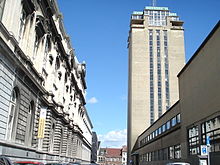
The University of Ghent , with about 44,000 students (as of 2019) in addition to the Catholic University of Leuven, the most important university of the Flemish Community and one of the most important and largest in the country. In addition, there are other institutions, such as the Hogeschool Gent with around 16,000 students, which today also includes the Koninklijke Academie voor Schone Kunsten (KASK) and the Koninklijk Conservatorium of Ghent, the Artevelde (Art) University (9,000), the university of sciences and Art (1500) and the University Odisee (Odisee University College, 10500). For the 2009/2010 academic year, a total of around 65,000 students were enrolled at the Ghent institutions - the top position in Belgium. This massive increase recently led to a lack of suitable living space.
The University Clinic Ghent (Universitair Ziekenhuis Gent) fulfills central medical functions for the entire region and even for parts of the Netherlands, especially for residents from Seeisch Flanders (Zeeuws-Vlaanderen), for whom Ghent is much easier to reach than the Erasmus MC Clinic of Rotterdam .
Culture and sport
Museums
There is a special museum pass for museums in Ghent. Most museums are open to residents of the city for free on Sundays between 10 a.m. and 1 p.m.
- Stadsmuseum Gent - City Museum for the History of the City of Ghent (STAM) in the former Bijlokeabbey
- Stedelijk Museum voor Actuele Kunst - City Museum for Current Art (SMAK) in Citadelpark
- Museum Dr. Guislain - History of Psychiatry and Temporary Exhibitions
- Museum voor Schone Kunsten - Museum of Fine Arts (MSK) in Citadelpark
- Museum voor Stenen Voorwerpen - Sankt Bavo Abbey
- Museum voor Industriële Archeologie en Textiel - Museum of Industrial Archeology and Textiles (MIAT)
- Huis van Alijn - House of Alijn, formerly a folk museum for folklore, everyday life and customs
- Museum voor Gerechtsvoorwerpen en het Wapenmuseum in de burcht Gravensteen - Court and weapon museum in Gravensteen Castle (Grafenstein)
- Arnold Vander Haeghen Museum
- Design Museum Gent (formerly: Museum voor Sierkunst - Museum of Ornamental Art)
- De Wereld van Kina Het Huis en De Tuin (voorheen: Schoolmuseum Michel Thiery )
- De School van Toen - The school of yore
- Ghent Belfry - Museum in the Belfry of Ghent
- Museum van het Groot Begijnhof - Museum of the great St. Elisabeth Beguinage
- Museum van de Beschers van Liefde van Jezus en Maria - Museum of the Sisters of Love of Jesus and Mary
- Kunsthal Sint-Pietersabdij - St. Peter's Abbey Art Hall
- University museums:
- Museum voor Geschiedenis van de Geneeskunde - Museum for the history of medicine
- Museum voor de Geschiedenis van de Wetenschappen - Museum of the History of Science
- Museum voor Dierkunde - Museum of Animal Science
theatre
In Ghent there is the NTGent, Minard and Capitole theater. Ghent and Antwerp host the Flemish Opera. The concert hall Handelsbörse on the Kouter is important for performances of contemporary or classical music.
Events

The city hosts numerous cultural events. The Festival van Vlaanderen is a music festival that has been held annually in different locations since 1958. Classical instrumental music and church music are on the program. The Gentse Feesten are a free ten-day street, music and culture festival that takes place throughout the city center in July. Since the 1960s they have grown into one of the largest folk festivals in Europe. In July 2015, around 1.38 million people visited the Gentse Feesten . Ghent celebrates Carnival with music, theater and spectacles. The Ghent Jazz Festival , the Street Theater Festival , the Puppeteer Festival and the I Love Techno Festival also take place annually. With the Flanders Expo , the city has the second largest multifunctional hall in Belgium.
In the cinematic field, the International Film Festival van Vlaanderen-Gent takes place every year , and the World Soundtrack Awards have been part of its supporting program since 2000 .
There is a Christmas market in the square in front of the cathedral. The Royal Music Association organizes the Christchöre Festival , where a large number of choirs in the city perform. An annual fair and a spring fair take place every year. Every five years, the Ghent Floralies open their doors to lovers of flowers and plants.
The Flikkentag is an open day , which regularly takes place the Ghent police since 1998th Since the success of the Flikken TV series, the event has been organized around the series and, after a few years, attracted around a hundred thousand visitors.
The poetry route is a walking path that leads hikers past 18 poems in downtown Ghent.
language
In contrast to the north, dialects are much more widespread and more pronounced in Flanders. The headstrong Dutch urban dialect spoken in Ghent differs particularly strongly from other rural dialects spoken in East Flanders.
In the Middle Ages, Ghent was the first place in the County of Flanders whose language came under the influence of Brabant, which resulted in East Flemish developing from Ghent. Before that, the people here also spoke dialects that are now considered to be West Flemish. Many of the linguistic developments were carried over to other cities and the rural population through the importance of Ghent. But just as some innovations remained within the city walls, language developments outside of Ghent later appeared that did not make it behind the city walls, so that Ghent, with its genuine urban dialect, increasingly developed into a dialectal island of language.
As the city grew into the suburbs at the end of the 19th and beginning of the 20th centuries, Sint Amandsberg, Gentbrugge and Ledeberg fully adapted to the dominant bourgeois dialect of the city center. In parts this also applies to Wondelgem and Mariakerke, in other areas such as Drongen and Evergem Oostakker this process is currently taking place. The language island around Ghent continues to expand.
In addition to the bourgeois dialect, there is also the dialect of the lower classes, which differs even further from the other East Flemish dialects.
The vocabulary does not differ significantly from the surrounding dialects , also in terms of phonology . After Brussels, Ghent was the most “frayed”, i.e. linguistically Frenchized, city in the Dutch-speaking area of Belgium in the 19th and early 20th centuries. The town's bourgeoisie was entirely French-speaking, so there are still far more French loanwords in Ghent than in the rest of East Flanders. It may well be that a term is used in Ghent that is unknown in the rest of the language area.
Examples of this urban dialect can be found in famous Ghent songs like 't Vliegerke by Walter De Buck, De sterkste man van Gent and In mijn stroate zijnt allemaol comeeren .
Stroppendragers
The inhabitants of Ghent are nicknamed Stroppen or Stroppendragers ( knitting carriers ). Because they had stood up against war taxes, Emperor Charles V humiliated the notables of his native Ghent in 1539 by having to wear a rope around their necks after his victory. The noose stayed alive in Ghent folklore. During the Ghent Festival ( Gentse Feesten ), many citizens wear black and white ropes around their necks every year . This is due to the main colors of the city's coat of arms, the white lion on a black background.
literature
Ghent holds an important place in Dutch-speaking culture. Ghent authors, poets and chroniclers included Lucas d'Heere, Carel van Mander, and Dathenus. Due to the decline of Ghent after the Reformation, Ghent's literary life was forgotten for centuries. Only after 1830 did Ghent play a leading role in the literary field again with authors such as Jan Frans Willems , Julius Vuylsteke, Karel Ledeganck, Karel Van de Woestijne , Richard Minne, Prudens Van Duyse, Hippoliet Van Peene , Achilles Mussche, Maurice Roelants, the Virginie siblings en Rosalie Loveling, Cyriel Buysse , Johan Daisne. There were also authors who wrote in French, such as the Nobel Prize winner Maurice Maeterlinck , Charles Van Lerberghe , Georges Rodenbach and Suzanne Lilar. Among the post-war authors are Pjeroo Roobjee, Marc Sleen (comic strip artist and author) and a few who mostly settled in Ghent during their student days: Pol Hoste, Geertrui Daem and Herman Brusselmans .
Walter De Buck worked as an author of song lyrics.
The Koninklijke Academie voor Nederlandse Taal- en Letterkunde ( Royal Flemish Academy for Dutch Linguistics and Literature ) is located in Ghent , in the David 't Kindt mansion in the Koningstraat on the Vlasmarkt.
painting
When it comes to painting, Ghent has less well-known names than other Flemish cities. In the Middle Ages these are Hugo van der Goes , Jan van der Asselt and Justus van Gent . In the 19th century it was primarily Philippe-Lambert Spruyt, Félix De Vigne, Joseph Paelinck and Pieter Van Hanselaere who became famous. The famous Latemser school consisted largely of genters, of which Gustaaf Van de Woestijne, Frits Van den Berghe , Robert Aerens, Gustaaf and Léon De Smet and Albert Servaes are the most distinctive.
Sports
|
|
architecture
Well-known builders were Louis Roelandt, Louis Minard and Jacob Gustaaf Semey. The city hall of Ghent , which was built between 2009 and 2012 in the middle of the historic center, was the subject of heated discussion .
Culinary
Waterzooi, Stoverij, Hutsepot, Genter Mokken, Kletskoppen, Mandelbrot, Kaas with local Tierenteynmostaard, Cuberdon ( better known as "Neuzekes") and beers such as Genter Tripel, Gruut en Stropken. Since 2009, the city has tried a weekly vegetarian day on Thursdays. Ghent has the most vegetarian restaurants in Belgium per 100,000 inhabitants.
Personalities
Famous people from Ghent include Jacob van Artevelde , John of Gaunt, 1st Duke of Lancaster - important person in the Hundred Years War , Emperor Charles V , the astronomer Adolphe Quetelet , the politician and Prime Minister Paul de Smet de Naeyer , the Writer Maurice Maeterlinck , the IOC President Jacques Rogge , the singer Helmut Lotti and the spaceman Frank De Winne .
Town twinning
Ghent maintains partnership relationships with the following seven cities / municipalities ( zustersteden ):
- Saint-Raphaël , France , since 1958
- Wiesbaden , Germany , since September 4, 1969
- Kanazawa , Japan , since 1971
- Melle , Germany , with Sint-Denijs-Westrem since 1977
- Mohammedia , Morocco , since 1982
- Tallinn , Estonia , since 1982
- Nottingham , UK , since 1985
There is also an institutionalized collaboration with three cities ( partner cities ):
Ghent in film and television
- TV series: Code 37 , Flikken, Telenovela Louislouise
- Film: Recently in Belgium (Aanrijding in Moscou) , Ben X , Alias, Man zkt vrouw, Monuments Men - Unusual Heroes (The Monuments Men)
literature
- Belgium . Karl Baedeker, Ostfildern 1998, ISBN 3-87504-417-7 , pp. 226-244.
- Detlev Arens : Flanders . DuMont Reiseverlag, Ostfildern 2005, ISBN 3-7701-3005-7 , pp. 105–129.
- Reinhard Tiburzy: Belgium . DuMont Reiseverlag, Cologne 2004, ISBN 3-7701-6097-5 , pp. 103-114.
Web links
- Official website of the city of Ghent (Dutch)
- Visit Gent
- Archeoweb Gent
- inventory onroerend erfgoed
- Koninklijke Academie voor Nederlandse Taal- en Letterkunde
- Geentse Feesten
Individual evidence
- ↑ Statistics Belgium; Werkelijke bevolking per gemeente op 1 januari 2008 (excel-file) ( Memento from 26 January 2009 in the Internet Archive ) Population of all municipalities in Belgium, as of 1 January 2008, accessed on 19 October 2008.
- ↑ Statistics Belgium; De Belgische Stadsgewesen 2001 ( Memento of March 25, 2009 in the Internet Archive ) PDF file, accessed on October 19, 2008.
- ↑ Ghent - climate tables
- ↑ Source: Gemeentelijk Structuurplan Gent
- ↑ Gent - stadsuitbreidingen tot de 16de-eeuwse omwalling In: De Inventaris van het Bouwkundig Erfgoed.
- ↑ Illustration by Frans Hogenberg from 1576: Gendt in Flandren a great place, The Spanse has hauff fatzett, ... ( digitized version )
- ↑ Horst Lademacher : History of the Netherlands. Politics - Constitution - Economy . Wissenschaftliche Buchgesellschaft, Darmstadt 1983, ISBN 3-534-07082-8 , p. 153.
- ^ Cilli Kasper-Holtkotte: New in the West. Migration and its consequences: German Jews as pioneers of Jewish life in Belgium, 18./19. Century , Leiden 2003, p. 126 f.
- ^ Cilli Kasper-Holtkotte: New in the West. Migration and its consequences: German Jews as pioneers of Jewish life in Belgium, 18./19. Century , Leiden 2003, p. 127.
- ↑ Ghent: Demographic gegevens 2013 .
- ↑ College van burgemeester en Schepenen. City of Ghent, accessed September 29, 2019 (Dutch).
- ↑ Sabine van Damme: Mathias De Clercq wordt nieuwe burgemeester Gent: "We willen een stad die voorop loopt maar ook achterom kijkt". Het laatest nieuws, November 30, 2018, accessed on September 29, 2019 (Dutch).
- ↑ vlaanderenkiest.be Official election results 2012
- ↑ Results of the Ghent municipal council elections. Flemish Government, accessed 29 September 2019 (Dutch).
- ↑ Seen and photographed in September 2019 by user: 44Penguins .
- ↑ Tom Dams, Nicholas De Cocker: Gent gezelligste stad van Vlaanderen. In: Het Nieuwsblad. October 27, 2004 ( nieuwsblad.be ).
- ↑ Gent is Gezelligste stad van Vlaanderen. In: Gazet van Antwerpen. October 26, 2004 ( gva.be ).
- ↑ Langemunt is kwarteeuw autovrij. In: De Standaard , September 28, 2007 ( standaard.be ).
- ↑ Mobility plan in the inner city of Ghent ( Memento of March 2, 2011 in the Internet Archive ) (PDF; 648 kB).
- ^ Frank Binder: Gent: Less cover . In: Daily port report from January 18, 2016, p. 16
- ↑ Eckhard-Herbert Arndt: Ghent maintains the previous year's result · Inland shipping showed some weaknesses in 2014 · Schleusenengpass felt again . In: Daily port report from January 15, 2015, p. 13
- ↑ Tobias Müller: Where cyclists have right of way: Everything eco in green Ghent . In: The daily newspaper: taz . September 11, 2018, ISSN 0931-9085 ( taz.de [accessed September 18, 2018]).
- ↑ Gent door de jaren…: De ontwikkeling van de Gentse Pers tussen 1667 and 1974 .
- ↑ Corelio Media: Geschiedenis .
- ^ Ghent University: Facts and figures (English). Retrieved March 11, 2019.
- ↑ Odisee University College website. Accessed July 21, 2018 (English).
- ↑ " Gentse Feesten trek 1.5 miljoen mensen " Provinciale Zeeuwse Courant (PZC) , July 28, 2015.
- ↑ " Gentse Feesten klokken af op 1,38 miljoen bezoekers " Het Nieuwsblad , July 27, 2015.
- ^ Koninklijke Atletiek Associatie Gent .
- ↑ KAA Gent .
- ↑ FRBE-KBSB: 401: KGSRL / Koninklijke Gentse Schaakkring Ruy Lopez
- ↑ FRBE-KBSB :: 402: JEAN JAURES GENT / SC Jean Jaurès .
- ↑ Deutsche Welle film from July 9, 2009 .
- ↑ Zustersteden. City of Ghent, accessed February 14, 2020 .
- ↑ partner cities. City of Ghent, accessed February 14, 2020 .



